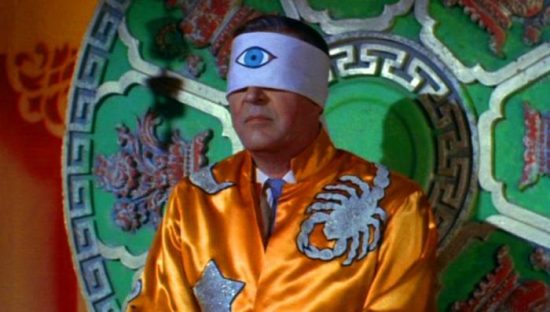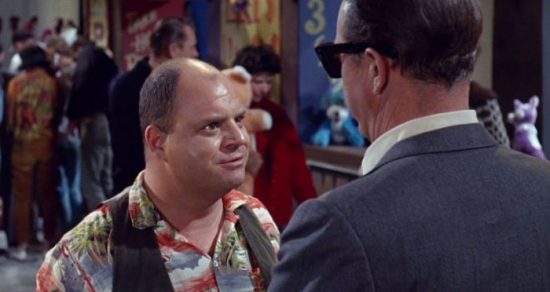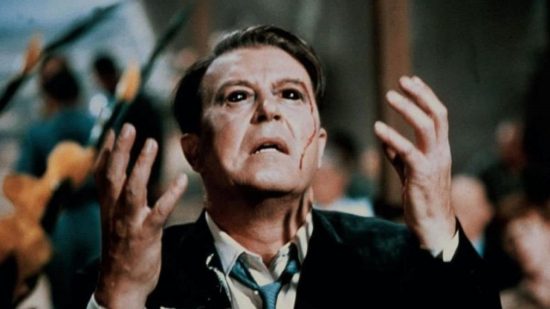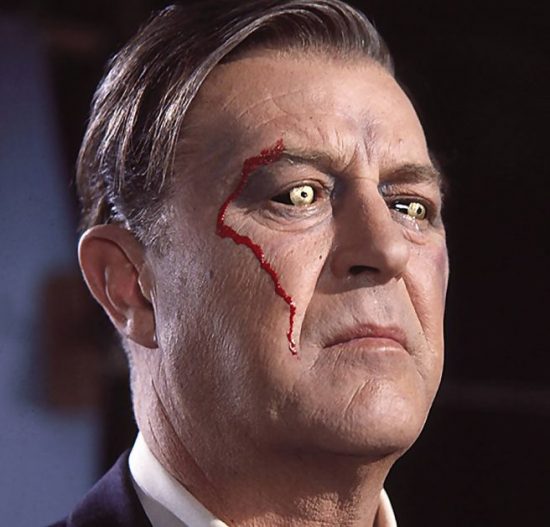Review: The Man With The X-Ray Eyes – “A very unusual slice of 60s Sci-fi horror”
Directed by Roger Corman
Starring Ray Milland, Diana Van der Vlis, Harold J Stone, John Hoyt, Don Rickles
Here’s an underrated gem from the stable of the legendary Roger Corman, 1963’s The Man With The X-Ray Eyes (aka X: the Man With The X-Ray Eyes). I remember reading about this in some movie monster books when I was a kid, and seeing it late night on TV in my teens, but it rarely aired as often as the old Hammer or Universal movies did, and I haven’t seen it in decades. So I am delighted that Second Sight has brought it back, and indeed given it the deluxe treatment: a limited edition Blu-Ray set with a newly restored print, plenty of extras (including interviews with Roger Corman and Joe Dante), poster, a book by Jon Towlson and Allan Bryce, and boasting excellent new cover artwork by the always-brilliant Graham Humphreys.
For those who haven’t seen this very unusual slice of 60s Sci-fi/horror, made between shooting some of those iconic Edgar Allan Poe films Corman is still, rightly, highly regarded for, it follows Doctor James Xavier (Ray Milland), a physician who is working on an experimental mixture which he administers as eye droplets, with the goal of allowing human sight to be expanded. As he explains to his ophthalmologist friend Doctor Sam Bran (Harold J. Stone), in the last few decades humans have discovered a wide electromagnetic spectrum – ultraviolet, X-rays and more – that their natural senses cannot see. What if they could, with their own eyes, not with imprecise instruments? Imagine how this would help a medical doctor – no fuzzy X-Ray plates, they can literally see through flesh and bone to diagnose an illness, formulate the correct treatment.
While his friends caution him for pushing too far, too quickly, Xavier is eager to test his work, despite the death of a test animal. His reasoning is that the animal couldn’t comprehend what its new visual senses showed it, but he, as a rational, intelligent being, can learn to do so. He is, well, partially correct – at least at first. He finds his new vision increasing, going from being able to read a letter through another sheet of paper covering it, to being able to see into a patient being readied for surgery, a young woman, and he can see what is wrong – a different diagnosis from the attending surgeon, leading to a showdown between the pair as Xavier uses his new powers to save her life.
It’s at this point that things start to spiral out of control – the medical authorities will not accept his abilities, and therefore not believe them as his excuse for his behaviour in the operating theatre (despite saving the patient). His career hanging in the balance, his research funding cut, struggling to control his new abilities, a terrible accident leads to him having to flee to avoid arrest. Desperate for somewhere to hide and continue his research (and a way to reverse the new visual abilities too), Xavier takes refuge, of all places, in a carnival sideshow, posing as a stage magician who can read minds and tell secrets (it’s here he comes into contact with the nasty, selfish carnival barker Crane, played by Don Rickles, in a rare straight, dramatic role), before also trying to use his new abilities to win in Vegas, to get sufficient funds to get his research going once more.
It remains one of the more unusual horror classics of that era – amazingly shot in something like three weeks for a budget of only $300, 000 (tiny, but huge by the normal American International Pictures’ budget standards!). Naturally, given the era it was made in, the special effects are not exactly dazzling – to be fair, this isn’t just because of budget restrictions, the technology to show what they really wanted was simply not there at the time. Despite this, the effects team and art director still, in my opinion, managed to give the viewer the feeling of Xavier’s increasing dislocation, as his powers grow, as he can see more and further.
The visual processing in the human brain is enormously complex (as AI programmers have found in trying to replicate it with technology), and also relies on years of us learning to interpret the visuals coming into our brain into something coherent. While Xavier can cope with the titular X-Ray vision, as he begins to see more, things he didn’t even know existed, seeing into matter and the universe itself, he’s slowly losing his mind, and those visual effects, for all their early crudeness, do a good job of conveying this, in conjunction with the excellent Milland’s acting. (it isn’t all drama and doom though, there is some fun to be had, such as Xavier realising he can see through everyone’s clothes at a party, a nod to the old X-Ray specs gimmicks sold in the back pages of comics).
Adding much to this story is the fact that this isn’t the formulaic Mad Scientist story. Yes, Xavier may have a little arrogance of the highly skilled doctor who believes he knows better than others, but he’s not a bad man, and risking his career to save the young woman using his powers shows that he is a decent man. He genuinely wants to use these new abilities to advance medicine, to save more lives, to expand scientific knowledge, and that’s a large part of what really makes this such a compelling film because he’s not a madman trying to take over the world, he’s a pioneer, with his heart in the right place, who succumbs eventually to the new, uncharted discoveries he has made, like the Curies and other scientists before him.
“What did he see?” asks his love interest, Doctor Diane Fairfax (Diana Van der Vlis) of the unfortunate test monkey who proves the formula works but dies afterwards. Those words haunt the film, as the abilities Xavier has gained become cumulative, taking him far beyond even the broadest speculations in science, into new realities he simply cannot cope with. He can’t even escape by closing his eyes now, because he can see right through the lids. This well-intentioned work leading to disaster lends the story a deeper, emotional, tragic aspect that compels as strongly as the idea of the new discovery does. An absolute classic of Sci-fi and Horror.
The many extras in this special edition are also great, not least the iconic Corman talking about the making of the film, how he came up with the rough idea, originally thinking he knew some of his musician friends on the jazz scene dallied in drugs, and perhaps he should make the central character a musician who overdoses, before realising he hated that idea, and going back to the notion of having a scientist, someone who was pushing into new frontiers without realising what the consequences would be. Corman also talks about his desire to remake the film, with modern effects able to realise the remarkable new visual abilities of Xavier in any way they want. Personally, while the story is strong enough to stand a remake, and the modern visuals would indeed be better, as I said, it isn’t the visuals which really make this film so powerful, it’s the central idea and especially Milland’s performance that do so.
The Man With X-Ray Eyes will be available from Second Sight Films on limited edition Blu-Ray from May 4th.














